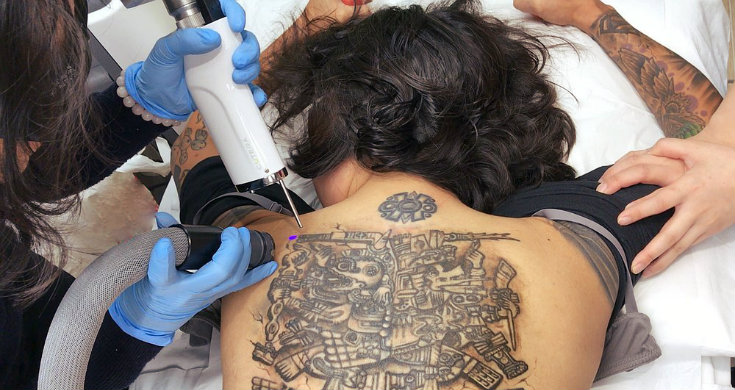-
28 February 2020
How Does Laser Tattoo Removal Work Beneath The Skin?

Laser tattoo removal has become a popular treatment among people who are distressed about the ink on their skin. The safety and surety of this procedure have made many jump the bandwagon and get their regrettable tattoos removed under the guidance of an able laser practitioner.
Although it has become a mainstream remedy, the working of the procedure is still not understood by many. If you intend to undergo laser tattoo removal in Melbourne, then it is imperative to know how it works to give you an ink-free skin. Here is a rundown on the mechanics behind the treatment and how it works beneath the skin.
The ink used for tattooing is made up of heavy metals such as copper, lead, mercury, etc. As soon as the ink is deposited into the deep layer of the skin, it is identified as a foreign body by the immune system. Our natural defence mechanism gets into action and sends out white blood cells(WBC) to remove the ink.
The cells engulf the small ink particles and transport them to the liver for excretion. However, most of the ink particles are too big to be carried by the WBCs and hence become a permanent part of the skin. The small parts that are removed make the ink a little faded.
The laser tattoo removal procedure is usually carried out without administering local anaesthesia as it causes bearable discomfort. However, topical anaesthesia may be applied if demanded by the patient. Q-switched laser or ultra-short pulse laser technology is the most commonly used laser type for this treatment as it produces a strong and single pulse of energy.
For dark-skinned patients, the practitioners opt for Q-switched Nd:YAG laser to avoid pigmentation. The fast and narrow frequency laser helps in breaking down the ink particles. Multi-hued tattoos need lasers with varying wavelengths to break the variety of inks.
Also, tattoos which are smaller in size need fewer pulses, and the big ones need more pulses. The ruptured ink particles are then picked up by the WBCs and taken to the liver to be eliminated with the help of the lymphatic system.
The laser heats the ink rapidly, which makes the ink shatter. It does not affect the surrounding tissue as the laser is highly targeted on the ink, and this process is known as selective photothermolysis. The gas created by the heat is released from the skin and forms a chalky layer on the tattoo known as frosting.
It is a temporary appearance and goes away in some time. The process takes several sessions to completely remove the ink from the skin, which are spaced four to six weeks apart. People with sensitive skin may have to wait longer between sessions as this time is used by the skin to get rid of the ink and start healing.
Since the bloodstream plays a significant role in transporting the ink particles, tattoos that are positioned close to the heart are removed quickly. The reason behind this is simple. The rate of circulation is highest near the heart, which makes it easier for the lymphatic system to move the ink particles to the liver.
So a tattoo placed on your limbs will take more time to fade as compared to the one inked on your shoulder. The skin tone of the patient also makes a difference in the duration of the treatment. It is easier to remove tattoos in case of light-skinned people while the process becomes a bit complicated for dark or tanned individuals.
Also, a tattoo done by an amateur artist is easier to remove as the ink is not too deep. On the other hand, tattoos done by professionals may take more time as they are spread evenly and deeply into the skin.
Additionally, different tattoo ink colours react differently to the laser. Blue and black tattoo inks can be effectively removed with the laser while other colours require a longer procedure. Thus the number of sessions is dependent on the position, size, depth and colour of the tattoo. Usually, a standard tattoo may take six to ten appointments for removal.
Although there are other tattoo removal procedures present such as dermabrasion and surgical tattoo removal, laser tattoo removal is the safest option. It is highly recommended by dermatologists. The best way to ensure the success of the procedure is to visit a reputable skin clinic and consult a licensed and qualified laser technician.
They must have the appropriate license to operate the ‘Class 4’ lasers and have rich experience in conducting the treatment. If you think about saving a few dollars and opt for an inexperienced technician, you can end up with burns, blisters, and even scars. So make sure that you seek the advice of an expert.
The elimination of the ink particles from the body can be intensified by working on the immune system that helps in detoxification. Thus people undergoing laser tattoo removal in Melbourne must eat a healthy and balanced diet, exercise to improve blood circulation and sweat out the toxins from the body.
They should stay away from the sun and apply sunscreen while going out as well as drink lots of water to stay hydrated. Besides all this, they must quit smoking and other such bad habits that can slow down the immune system.
Laser tattoo removal is an intricate and time-consuming procedure which needs patience. Thus you must stick to the timeline of the treatment provided by your dermatologist and complete each session without any delay to get the best results.